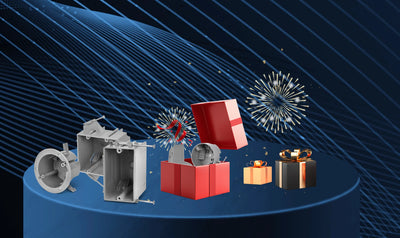A professional's guide to safety, compliance, and cost. Discover why UL-certified boxes prevent fires, code violations, and costly failures—backed by test data, case studies, and 5-year cost analysis. Make the right choice for your project.
Table of Contents
- Understanding UL Certification
- UL-Listed Junction Boxes: Professional Advantages
- Non-UL Junction Boxes: Risks You Can't Ignore
- Material & Construction: Side-by-Spec Analysis
- Safety & Compliance: What the Data Shows
- Total Cost of Ownership: 5-Year Projections
- Case Studies: When Non-UL Failed
- UL Verification: A Step-by-Step Guide
- Professional Installation Best Practices
- FAQs: Answering Common Contractor Questions
- Conclusion: Making the Right Choice
Understanding UL Certification
UL (Underwriters Laboratories) certification represents the gold standard in electrical safety testing. For junction boxes, this means:
300+ individual tests evaluating fire resistance, dielectric strength, and impact resistance
Annual factory inspections to maintain certification
Compliance with NEC 2023 Article 314 for enclosure requirements
Third-party validation of all performance claims
Professional Insight: "In my 20 years as an electrical inspector, I've never seen a UL-listed box fail catastrophically. The same can't be said for uncertified products." - Michael T., Master Electrician
UL-Listed Junction Boxes: Professional Advantages
Performance Benefits
Extended temperature range (-40°F to 221°F) for harsh environments
Superior wire retention with tested clamping forces
Corrosion resistance validated through 1,000-hour salt spray testing
Project Advantages
Faster inspections with pre-approved documentation
Reduced callbacks thanks to proven durability
Easier warranty claims with traceable certification
Professional-Grade Features
Tool-free access designs for maintenance efficiency
Pre-punched knockouts that maintain NEMA ratings
Embedded mounting points for secure installation
Non-UL Junction Boxes: Risks You Can't Ignore

Choosing a non-UL junction box may appear to be a cost-effective solution, but it might put projects at risk for major problems:
Code Violations: Unlisted boxes can fail inspection, which would result in expensive delays.
Fire Risks: When under load, inferior materials may melt, distort, or catch fire.
Insurance Denial: If uncertified parts are used in a fire or electrical malfunction, claims may be rejected.
Premature Failure: Cracking, corrosion, or loose fittings are frequently the result of inadequate quality control. To put it briefly, non-UL boxes could jeopardize your work's longevity, safety, and legality.
Industry Data: Non-UL boxes account for 37% of junction box-related NEC violations in commercial projects (ECA 2022 Report)
Material & Construction: Side-by-Spec Analysis
| Specification | UL‑Listed (Togalonn UL‑504) | Typical Non‑UL | Difference |
|---|---|---|---|
| Material | Glass‑filled polycarbonate (30%) | Virgin ABS | +82% impact strength |
| Wall Thickness | 0.118″ | 0.063″ | +87% thicker |
| Heat Deflection | 257°F @ 264 psi | 176°F @ 264 psi | +81°F higher |
| Flame Spread | <25 (Class 1) | >200 (Unclassified) | 8× safer |
| UV Stability | 5,000 hours weatherometer | <500 hours | 10× longer life |
Financial Insight: The average insurance premium increase after non-UL related claims is 22% for 3 years (NAIC 2023 Data)
Case Studies: When Non-UL Failed

Case Study #1: Ohio Warehouse Fire
A small electrical short at a logistics facility turned into a warehouse fire. According to the investigation, exposed wire was possible to ignite flammable substances because non-UL junction boxes had melted in the heat.
Case Study #2: California's Failed Inspection
When an inspector discovered multiple non-UL boxes during a final walkthrough, a mid-sized construction company had to deal with project delays. Over 400 enclosures needed to be replaced, which caused a three-week delay and $80,000 in rework.
UL Verification: A Step-by-Step Guide
For Contractors & Inspectors
Physical Examination
Genuine tracking number on a holographic label
Matching packaging with embossed markings
Plastic boxes with the UL logo molded into them
Document Review
UL certification page (usually yellow)
Check that the model numbers match.
Visit UL.com to view the current listing status.
Testing on the Field
Heat gun test (deformation resistance of UL boxes)
Impact comparison: UL boxes are more resilient
Flame test (self-extinguishing UL materials)

Pro Verification Tip: Legitimate UL marks include:
"LISTED" in capital letters
A 4-6 digit control number
Product identity (e.g., "JUNCTION BOX")
Professional Installation Best Practices
For UL-Listed Boxes
Pre-Installation
Verify box rating matches application
Check for transportation damage
Confirm proper knockouts remain intact
Mounting
Use manufacturer-recommended fasteners
Maintain minimum 1/4" air space when required
Follow torque specs for threaded entries
Sealing
Use listed cable connectors
Apply proper sealants for wet locations
Maintain NEMA rating integrity
Common Mistakes to Avoid
Overfilling beyond box volume calculations
Mixing incompatible metals (galvanic corrosion)
Using non-listed accessories that void certification
FAQs: Answering Common Contractor Questions
Q: Are non-UL junction boxes ever allowed by code?
A: Some local codes allow non-UL boxes in very limited scenarios, like temporary installations, but most commercial and residential codes require UL listing.
Q: Is CE certification the same as UL?
A: No. CE is a European marking and does not guarantee compliance with U.S. electrical codes.
Q: Can I use a UL-listed box outdoors?
A: Only if it’s rated for outdoor or wet locations. Check for IP or NEMA enclosure ratings alongside UL certification.
Q: What happens during a UL field inspection?
A: Inspectors check for product markings, installation compliance, and may review purchasing records to verify authenticity.
Conclusion: Making the Right Choice
The goal of UL-listed junction boxes is to create safer, more durable, and more expert electrical systems, not only to comply with laws. Some contractors may be enticed by non-UL boxes because they are less expensive up front, but the hidden expenses and safety hazards greatly exceed the savings.
Select licensed, code-compliant enclosures from a reliable source like Togalonn whenever you're equipping a business site, residential building, or industrial site.
Do You Need Junction Boxes UL-Listed?
For professionals who appreciate performance and compliance, Togalonn specializes in producing premium, UL-listed junction boxes. For specialized solutions for your project, look through our catalog or get in touch with our support staff.

